
Bohol Island is part of the Visayas in the Philippine archipelago, just off Cebu’s east coast, but it has a personality all its own. From its flat inland plateaus of electric green to its powdery white beaches and rushing rivers, from its quirky markets and churches to its fantastic wildlife encounter opportunities, there’s so much to see.
In this guide, I’ll prepare you for a satisfying and immersive trip around Bohol: how to get to Bohol, where to stay, what to do, and how to get around will all be addressed.
Note that you may want to pair this guide with my itinerary-style guide to Cebu Island.
Getting to Bohol
By ferry
There are lots of ferry routes going from Cebu Island to Bohol. The most popular routes, along with the time taken and approximate price for each, are found in the table below. All the routes and prices were found at 12Go.com, my favourite site for booking transit in Southeast Asia.
By air
Bohol technically has a few airports, but the one in Panglao (on the southern tip) is the only one that receives regular commercial flights.
The best airline to fly there domestically is Cebu Pacific and its regional arm, Cebgo. They offer flights from big Philippine cities like Cebu or Manila for $30-40. It’s a good option if you’re coming from another island or just want to avoid the ferry ride from Cebu.
The Panglao airport labels itself as “international,” but its service to or from Western countries is extremely limited.
Major towns on Bohol
Each night you stay on Bohol, you can choose to stay in one of these towns – the island is small enough for you to go between them in an hour or two.
You can refer back to the map of Bohol to get your bearings — but here’s a quick glimpse of the highlights:
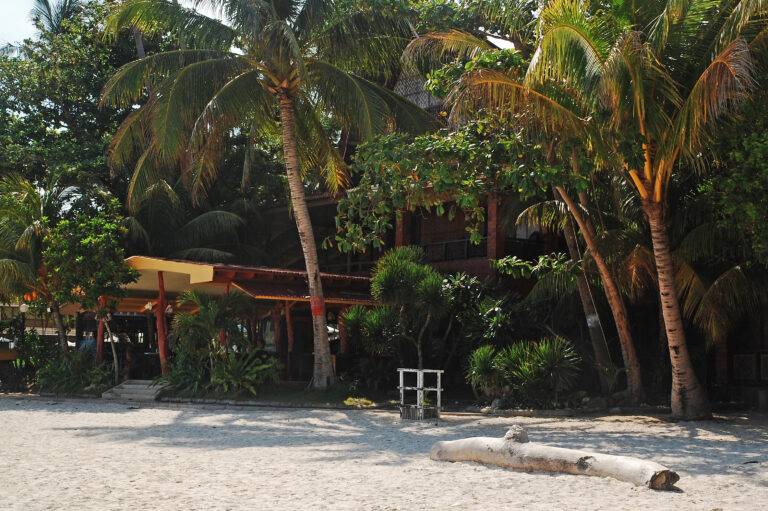 Palm-fringed shoreline in Panglao–Bohol’s main island-hopping and diving hub (WE_S/DepositPhotos)
Palm-fringed shoreline in Panglao–Bohol’s main island-hopping and diving hub (WE_S/DepositPhotos)  Chocolate Hills landscape – the defining highlight of Carmen
Chocolate Hills landscape – the defining highlight of Carmen 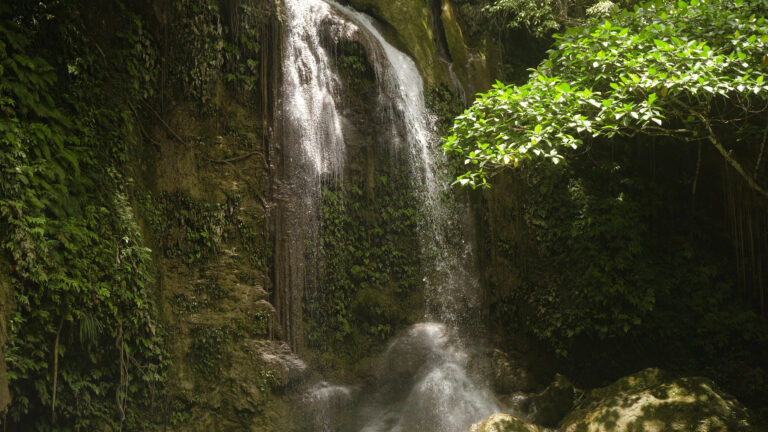 Hidden in towns like Dimiao and Balilihan, massive waterfalls cut through lush jungles and deep terrains
Hidden in towns like Dimiao and Balilihan, massive waterfalls cut through lush jungles and deep terrains
Panglao
Panglao, on the southern tip of Bohol, is the island’s main tourist hub, best for beach lovers and divers who prefer a developed tourist infrastructure.
It’s convenient with Panglao Airport nearby and some of the resorts there are really nice, but the scene can feel crowded and commercial. Great if you want nightlife and island-hopping tours; less so if you prefer a more authentic vibe.
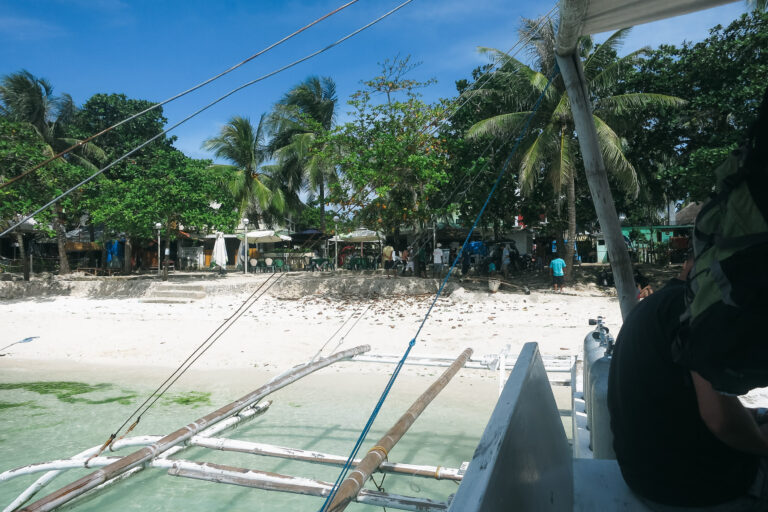 Heading off on a snorkeling trip from Panglao Beach
Heading off on a snorkeling trip from Panglao Beach
Tagbilaran
Just north of Panglao, Tagbilaran is Bohol’s busy capital, not a tourist hotspot but practical for ferries and transit.
Staying here puts you near restaurants, shopping, and local life rather than beaches. It’s ideal if you want a budget base or a taste of everyday Bohol. Downsides: heavy traffic and little charm compared to other towns. Most visitors just pass through, but it works if convenience trumps scenery.
Shout-out to AK Residences, my favourite budget hotel on Bohol.
Carmen
Carmen sits inland at the dead centre of Bohol, and it’s most famous for the Chocolate Hills (more on them later). It’s a quiet town, mostly farmland, with a few guesthouses for travellers seeking nature over nightlife.
Stay here if you want early access to the hills and unbeatable rural vistas, but don’t expect much to do after sunset.
Anda
On a peninsula off Bohol’s east coast, Anda is Bohol’s laid-back beach alternative to Panglao, with white sands, limestone caves, and great snorkeling spots that aren’t touristy like Panglao. It suits culture hounds or anyone wanting a quieter seaside getaway. There’s a small but growing backpacker scene, with some boutique resorts too. The one downside is that it’s far from any other developed town.
Tubigon and Ubay are two other fairly large towns on Bohol, but they didn’t quite make this list because there’s really nothing to do in either. Tubigon is mainly just a port town for receiving ferry passengers, while Ubay is an industrial and agricultural hub.
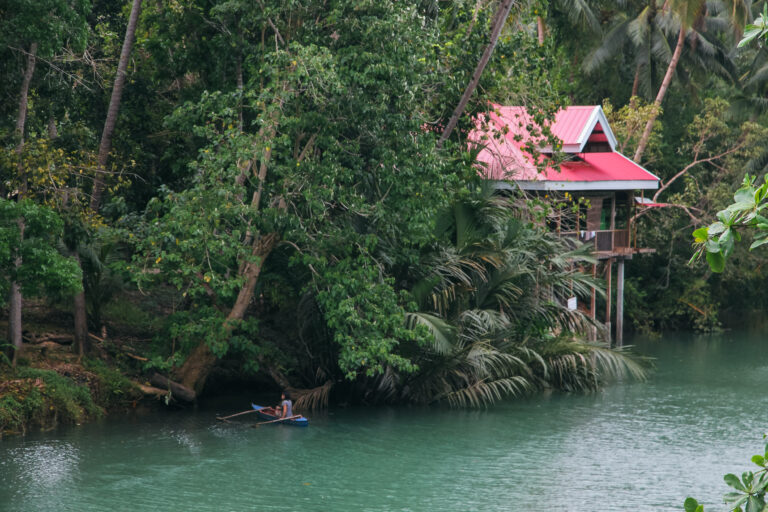
Above: Loboc is another lovely village to stay in the interior — it’s the perfect base for kayaking, firefly watching, and river boat trips. Nipa Hut Village is a great place to stay for budget travellers.
How to get around Bohol
Bohol Island is compact enough that you can get from one end to the other (Panglao-Getafe) in less than three hours, which means you’ll be able to explore Bohol from one end to the other once you secure transportation. The best ways to get around the island are:
Motorbike rental
This is the best method, as it allows for by far the most freedom and cultural immersion. Bohol is not hard to drive around, either; even the busier parts of the island have very little traffic, and the roads between cities are often traffic-free pleasure cruises.
You don’t need an international permit to drive in the Philippines; a valid licence from your home country will suffice. Some of the best motorbike rental services in Bohol’s major towns are recommended below. All of them rent inexpensive bikes for $6-10/day.
Maxim app
If you’re not driving yourself, you can hail a bike with Maxim, the Philippine answer to Uber. It will often cost around $25 for a ride from one city to another.
Maxim also offers rides via tricycle, a tuk-tuk-like option that’s common on Bohol. Tricycle rides are a bit more expensive, but they can seat more than one passenger and luggage.
Jeepney
Jeepneys are essentially open-air buses, and they travel between most cities on Bohol (Anda is the outlier for the cities mentioned above). They’re a great budget option for those who aren’t driving themselves, and they’re also good for meeting locals.
 The tricycles are quite cramped but fun — ideal for covering shorter distances
The tricycles are quite cramped but fun — ideal for covering shorter distances
What to do on Bohol
While on Bohol, travel around the island and try to check off as many of these activities as possible.
To help you plot your journey, refer to the map earlier in this post.
Explore the Chocolate Hills
Near the town of Carmen, over a thousand rolling limestone mounds stretch into the horizon. The mounds are almost perfectly symmetrical, rounded, and uniform, which gives them a strange, otherworldly look that feels more like sacred geometry than geological formations.
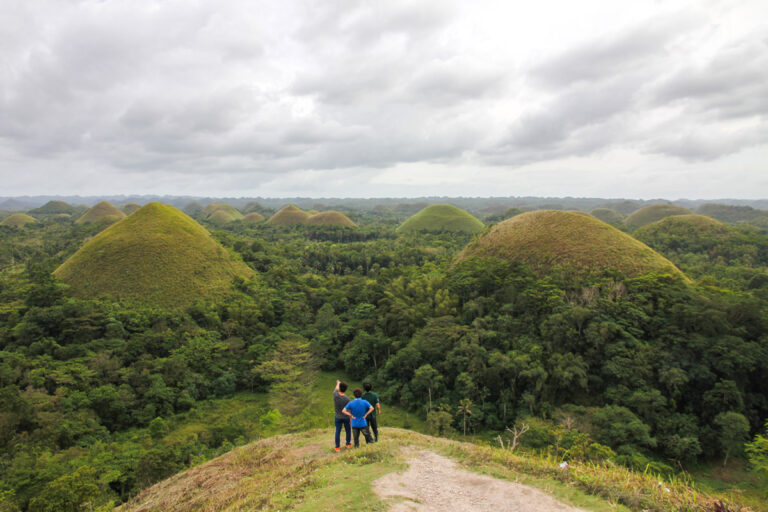 The chocolate hills of Bohol change their color to dark brown in autumn
The chocolate hills of Bohol change their color to dark brown in autumn
I went in the wet season when the hills were a bright green, but they turn brown in the dry season – hence the name.
There’s a viewing deck in Carmen that costs $2 and will give you the best panoramic view of the hills, and driving through the hills to actually climb atop the mounds is free.
Visit the Tarsier Sanctuary
With its saucer-like eyes, frog-like hands, and big, floppy ears, the Philippine tarsier is one of the most amazing animals I’ve ever seen in the wild.
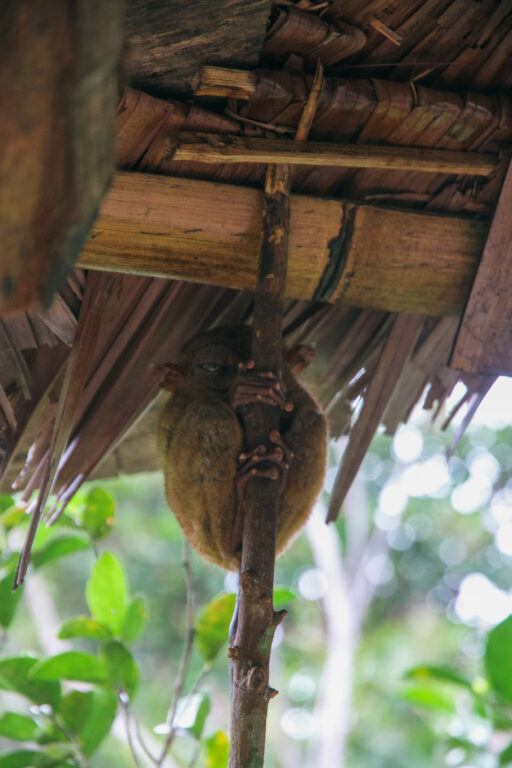

Sadly, it’s also endangered, which made me glad they were being treated well and allowed to roam free at the sanctuary that’s a 30-minute drive from Tagbilaran. I was disappointed to learn the tarsiers don’t really come up close to guests, but even a view from a distance was a cool experience.
Guided tours of the sanctuary cost $2.50, and the best time to visit is 2:30 or 3:00, after the tour bus crowds leave.
Take in the island at Alicia Panoramic Park
Located in an off-the-radar northeast corner of Bohol, very few visitors discover Alicia Panoramic Park. But an outdoorsy local I met near Anda told me it’s the best place around for a quick yet rugged trek, and I had to go.
The main path at Alicia follows a series of grassy hills with cinematic views of the island’s interior. The short hike is enough to feel adventurous without requiring serious gear, and sunrise or sunset makes the climb especially rewarding. It’s ideal for travellers wanting to break up their beach time with a dose of outdoor exploration.
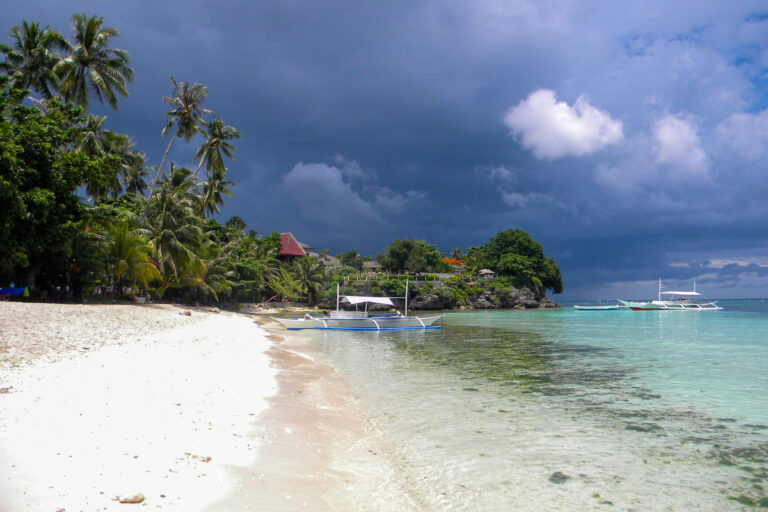
Go to the beach
Some of the best beaches I went to on Bohol are:
| Beach name | Tourism level | Snorkeling quality | Notes |
|---|---|---|---|
| Alona Beach (Panglao) | ⭐️⭐️⭐️⭐️⭐️ | ⭐️⭐️⭐️ | Lively, convenient, but overdeveloped. |
| Dapdap Beach (Tagbilaran) | ⭐️⭐️ | ⭐️⭐️ | Local beach vibe; more for atmosphere than swimming. |
| Quinale Beach (Anda) | ⭐️⭐️⭐️ | ⭐️⭐️⭐️⭐️⭐️ | Small but growing tourist area; white sands, clear water, authentic village vibe. |
| Henson Beach (Ubay) | ⭐️ | ⭐️⭐️⭐️ | Very uncrowded “country roads” vibe in the midst of a rustic fishing village. |
| Doljo Beach (Panglao) | ⭐️⭐️ | ⭐️⭐️⭐️⭐️ | Much less crowded alternative to Alona. |
PS: beaches on the map are marked in yellow.
Experience Christian heritage at churches
Since Bohol was the second Philippine island settled by Christian missionaries and it didn’t have the same level of resistance as Cebu did, it has a stronger Christian heritage than any other island in the country.
So it’s no surprise that the small island is home to over a dozen churches that are centuries old. Some of the best ones to visit are:
- La Purisima Concepcion de la Virgen Maria in Baclayon: One of the oldest stone churches in the Philippines; the coral-stone walls and attached museum are especially impressive.
- San Pedro Apostol in Loboc: A scenic riverside church with elaborate stone detailing.
- Our Lady of the Assumption in Dauis: The highlight is the wishing well inside the church. Locals often bring a bottle to collect blessed water, which makes a cool souvenir idea.
- St. Joseph the Worker in Tagbilaran: Bohol’s biggest cathedral, the painted ceiling is amazing and there’s a lot going on around the cathedral as well.
- Santo Niño in Anda: A small, quaint church near the beach.
PS: churches on the map are marked in purple.
Go on a river cruise
Bohol’s rivers, especially Loboc and Abatan, are sort of unique compared to nearby islands because they are flat, calm, and well-developed for tourism. Because of that, a foray along one of Bohol’s many rivers is practically a must.
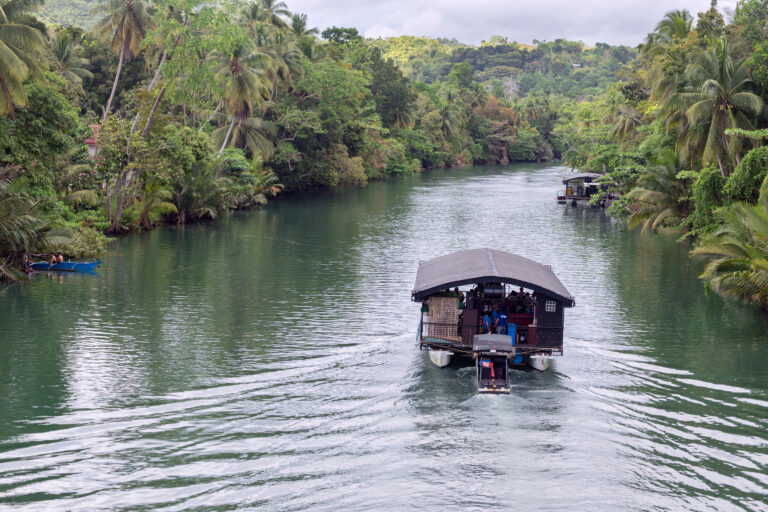 (aldarinho/DepositPhotos)
(aldarinho/DepositPhotos)
The Loboc River Lunch Buffet Cruise is the most popular option. It’s known for getting pretty lively, with lots of beer onboard and activities like dance parties and live music as the sun sets.
The Abatan River has a more rustic, undeveloped feel, and Abatan River Life allows visitors to explore it with their tours focusing on local community life and the wild nature along the river. They also offer kayaking or stand-up paddleboard tours.
Go caving
Bohol has a lot of shallow, dry caves – that is, they’re excellent for exploring on foot rather than by boat, like most of the underground river caves in the Philippines. A few on Bohol that were recommended to me by locals are:
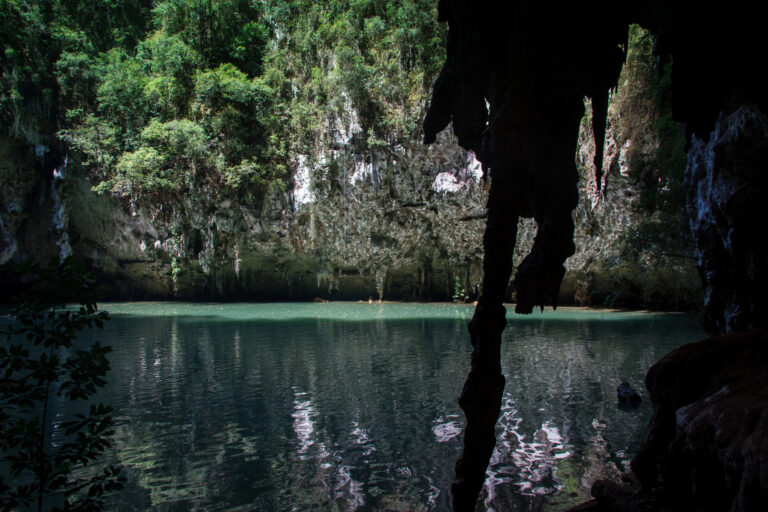
- Hinagdanan Cave, near Tagbilaran: An easy-to-access limestone cave with a natural window in the ceiling providing eerie mood lighting. It has an underground pool for swimming that locals say feels amazing, but the freezing water scared me off.
- Princess Manan-aw Cave, near Anda: This feels like the most of an ‘adventure’ of these three, because it has the coolest rock formations inside and requires you to swim at one point. It’s also the most slippery, so bring water shoes. The name comes from a local legend about a princess who vanished into its waters; don’t let yourself be the next victim.
- Combento Cave, near Anda: A compact, chapel-like cave named after its “convent” shape, with shallow waters and a perfectly peaceful ambiance. Locals sometimes use it for prayer, adding a cultural and spiritual layer to the experience.
Tours are available for the caves, but they’re totally safe to walk through alone. I’d recommend DIY exploration as long as you bring a flashlight and water shoes. The only issue is that the cave entrances can be tough to find, so don’t hesitate to ask locals for detailed directions if you need to.
PS: caves on the map are marked in grey.
Explore Bohol’s waterfalls
The island has numerous waterfalls, ranging from small cascades that are just nice for a quick swim to truly impressive 60m drops. Here are some of the waterfalls to go out of your way for:
| Waterfall | Nearest town | Height | Cost | Notes |
|---|---|---|---|---|
| Mag-aso | Tagbilaran | 8m/25ft | $1 | Twin falls that are easy to reach with concrete steps; popular for quick swims |
| Pahangog | Dimiao | 30m/100ft | $1 | A twin waterfall in a lush ravine. Less crowded, with natural rock pools at the base for swimming. |
| Camugao | Balilihan | 30m/100ft | $0.50 | Smaller pool, quiet and tranquil atmosphere compared to Mag-aso. |
| Can-umantad | Anda | 60m/200ft | $0.50 | Bohol’s tallest waterfall, a wide curtain of water that’s undoubtedly one of the most photogenic spots on the island. |
PS: waterfalls on the map are marked in red.
And that is it for our in-depth guide to Bohol! Remember that if you’re looking to expand your travel route, one of the best ways is to connect your trip in Bohol to a trip through Cebu. It’s a larger island with epic treks to distinctive limestone peaks, marine wildlife spotting opportunities (including whale sharks in Oslob), and numerous small beach towns where you can chill.
